MED-SURGE HESI RN 2022(101 Questions & Rationales)
Document Content and Description Below
MED-SURGE HESI RN (101 Questions & Rationales) 1. A patient on telemetry has a pattern of uncontrolled atrial fibrillation with arapid ventricular response. Based on this finding, the nrse anticipa... tes assisting the physician with which treatment? A. Administer lidocaine, 75 mg intravenous push. B. Perform synchronized cardioversion. C. Defibrillate the patient as soon as possible. D. Administer atropine, 0.4 mg intravenous push. Rationale: With uncontrolled atrial fibrillation, the treatment of choice is synchronized cardioversion to convert the cardiac rhythm back to normal sinus rhythm. Option Ais a medication used for ventricular dysrhythmias. Option C is not for a patient with atrial fibrillation; it is reserved for clients with life-threatening dysrhythmias, such as ventricular fibrillation and unstable ventricular tachycardia. Option D is the drugof choice in symptomatic sinus bradycardia, not atrial fibrillation. 2.A practical nrse (PN) tells the charge nrse in a long-term facility that she does not want to be assigned to one particular resident. She reports that the male patient keeps insisting that she is his daughter and begs her to stay in his room. What is thebest managerial decision? A. Notify the family that the resident will have to bedischarged if his behavior does not improve. B. Notify administration of the PN's insubordinationand need for counseling about her statements. C. Ask the PN what she has done to encourage theresident to believe that she is his daughter. D. Reassign the PN until the resident can be assessedmore completely for reality orientation. Rationale: Temporary reassignment is the best option until the resident can be examined and his medications reviewed. He may have worsening cerebral dysfunction from an infection or electrolyte imbalance. Option A is not the best option because the [email protected] [email protected] 3.Client census is often used to determine staffing needs. Which method of obtaining census determination for a particular unit provides the best formula for determining long-range staffing patterns? A. Midnight census B. Oncoming shift census C. Average daily census D. Hourly census Rationale: An average daily census is determined by trend data and takes into account seasonal and daily fluctuations, so it is the best method for determining staffing needs. Options A and B provide data at a certain point in time, and that data could change quickly. It is unrealistic to expect to obtain an hourly census, and such data would only provide information about a certain point in time. 4.The nrse is counseling a healthy 30-year-old female patient regarding osteoporosis prevention. Which activity would be most beneficial in achieving the client's goal of osteoporosis prevention? A. Cross-country skiing B. Scuba diving C. Horseback riding D. Kayaking Rationale: Weight-bearing exercise is an important measure to reduce the risk of osteoporosis. Of the activities listed, cross-country skiing includes the most weight-bearing, whereas options B, C, and D involve less. 5.Which condition should the nrse anticipate as a potential problem in a female patient with a neurogenic bladder? A. Stress incontinence B. Infection C. Painless gross hematuria D. Peritonitis Rationale: Infection is the major complication resulting from stasis of urine and subsequent catheterization. Option A is the involuntary loss of urine through an intact urethra [email protected] [email protected] as a result of a sudden increase in intraabdominal pressure. Option C is the most common symptom of bladder cancer. Option D is the most common and serious complication of peritoneal dialysis. 6.A client is being discharged following radioactive seed implantation for prostate cancer. What is the most important information that the nrse should provide to this client's family? A. Follow exposure precautions. B. Encourage regular meals. C. Collect all urine. D. Avoid touching the client. Rationale: Clients being treated for prostate cancer with radioactive seed implants should be instructed regarding the amount of time and distance needed to prevent excessive exposure that would pose a hazard to others. Option B is a good suggestion to promote adequate nutrition but is not as important as option A. Option C is unnecessary. Contact with the patient is permitted but should be brief to limit radiation exposure. 7. In assessing a patient with an arteriovenous (AV) shunt who is scheduled for dialysis today, the nrse notes the absence of a thrill or bruit at the shunt site. What action should the nrse take? A. Advise the patient that the shunt is intact and readyfor dialysis as scheduled. B. Encourage the patient to keep the shunt siteelevated above the level of the heart. C. Notify the health care provider of the findings immediately. D. Flush the site at least once with a heparinized saline solution. Rationale: Absence of a thrill or bruit indicates that the shunt may be obstructed. The nrse should notify the health care provider so that intervention can be initiated to restore function of the shunt. Option A is incorrect. Option B will not resolve the obstruction. An AV shunt is internal and cannot be flushed without access using special needles. [email protected] [email protected] 8. The nrse includes frequent oral care in the plan of care for a patient scheduled for an esophagogastrostomy for esophageal cancer. This intervention is included in the client's plan of care to address which nursing diagnosis? A. Fluid volume deficit B. Self-care deficit C. Risk for infection D. Impaired nutrition Rationale: The primary reason for performing frequent mouth care preoperatively is to reduce the risk of postoperative infection because these clients may be regurgitating retained food particles, blood, or pus from the tumor. Meticulous oral care should be provided several times a day before surgery. Although oral care will be of benefit to the patient who may also be experiencing option A, B, or D, these problems are not the primary reason for the provision of frequent oral care. 9.The nrse notes that the client's drainage has decreased from 50 to 5 mL/hr 12 hours after chest tube insertion for hemothorax. What is the best initial action for the nrse to take? A. Document this expected decrease in drainage. B. Clamp the chest tube while assessing for air leaks. C. Milk the tube to remove any excessive blood clot buildup. D. Assess for kinks or dependent loops in the tubing. Rationale: The least invasive nursing action should be performed first to determine why the drainage has diminished. Option A is completed after assessing for any problems causing the decrease in drainage. Option B is no longer considered standard protocol because the increase in pressure may be harmful to the client. Option C is an appropriate nursing action after the tube has been assessed for kinks or dependent loops. [email protected] [email protected] 10.The nrse is assessing a 75-year-old patient for symptoms of hyperglycemia. Which symptom of hyperglycemia is an older adult most likely to exhibit? A. Polyuria B. Polydipsia C. Weight loss D. Infection Rationale: Signs and symptoms of hyperglycemia in older adults may include fatigue, infection, and evidence of neuropathy (e.g., sensory changes). The nrse needs to remember that classic signs and symptoms of hyperglycemia, such as options A, B, and C and polyphagia, may be absent in older adults. 11.Which abnormal laboratory finding indicates that a patient with diabetes needsfurther evaluation for diabetic nephropathy? A. Hypokalemia B. Microalbuminuria C. Elevated serum lipid levels D. Ketonuria Rationale: Microalbuminuria is the earliest sign of diabetic nephropathy and indicates the need for follow-up evaluation. Hyperkalemia, not option A, is associated with endstage renal disease caused by diabetic nephropathy. Option C may be elevated in end-stage renal disease. Option D may signal the onset of diabetic ketoacidosis (DKA). 12. Which change in laboratory values indicates to the nrse that a patient with rheumatoid arthritis may be experiencing an adverse effect of methotrexate (Mexate) therapy? A. Increase in rheumatoid factor B. Decrease in hemoglobin level C. Increase in blood glucose level D. Decrease in erythrocyte sedimentation rate (ESR; sed rate) Rationale: Methotrexate is an immunosuppressant. A common side effect is bone marrow depression, which would be reflected by a decrease in the hemoglobin level. Option A indicates disease progression but is not a side effect of the medication. [email protected] [email protected] Option C is not related to methotrexate. Option D indicates that inflammation associated with the disease has diminished. 13. Which consideration is most important when the nrse is assigning a room fora patient being admitted with progressive systemic sclerosis (scleroderma)? A. Provide a room that can be kept warm. B. Make sure that the room can be kept dark. C. Keep the patient close to the nursing unit. D. Select a room that is visible from the nrses' desk. Rationale: Abnormal blood flow in response to cold (Raynaud phenomenon) is precipitated in clients with scleroderma. Option B is not a significant factor. Stress can also precipitate the severe pain of Raynaud phenomenon, so a quiet environment is preferred to option C, which is often very noisy. Option D is not necessary. 14. The nrse is reviewing routine medications taken by a patient with chronic angle-closure glaucoma. Which medication prescription should the nrse question? A. Antianginal with a therapeutic effect of vasodilation B. Anticholinergic with a side effect of pupillary dilation C. Antihistamine with a side effect of sedation D. Corticosteroid with a side effect of hyperglycemia Rationale: Clients with angle-closure glaucoma should not take medications that dilate the pupil because this can precipitate acute and severely increased intraocular pressure. Options A, C, and D do not cause increased intracranial pressure, which is the primary concern with angle-closure glaucoma. 15. The nrse is observing an unlicensed assistive personnel (UAP) performing morning care for a bedridden patient with Huntington disease. Which care measureis most important for the nrse to supervise? A. Oral care B. Bathing C. Foot care D. Catheter care [email protected] [email protected] Rationale: The patient with Huntington disease experiences problems with motor skills such asswallowing and is at high risk for aspiration, so the highest priority for the nrse toobserve is the UAP's ability to perform oral care safely. Options B, C, and D do notnecessarily require registered nrse (RN) supervision because they do not ordinarily pose life-threatening consequences. 16.During the change of shift report, the charge nrse reviews the infusions being received by clients on the oncology unit. The patient receiving which infusion should be assessed first? A. Continuous IV infusion of magnesium B. One-time infusion of albumin C. Continuous epidural infusion of morphine D. Intermittent infusion of IV vancomycin Rationale: All four of these clients have the potential to have significant complications. The patient with the morphine epidural infusion is at highest risk for respiratory depression and should be assessed first. Option A can cause hypotension. The patient receiving option B is at lowest risk for serious complications. Although option D can cause nephrotoxicity and phlebitis, these problems are not as immediately life threatening as option C. 17.The nrse assesses a postoperative patient whose skin is cool, pale, and moist. The patient is very restless and has scant urine output. Oxygen is being administeredat 2 L/min, and a saline lock is in place. Which intervention should the nrse implement first? A. Measure the urine specific gravity. B. Obtain IV fluids for infusion per protocol. C. Prepare for insertion of a central venous catheter. D. Auscultate the client's breath sounds. Rationale: The patient is at risk for hypovolemic shock because of the postoperative status andis exhibiting early signs of shock. A priority intervention is the initiation of IV fluids to restore tissue perfusion. Options A, C, and D are all important interventions but are of lower priority than option B. [email protected] [email protected] 18. A patient with type 2 diabetes takes metformin (Glucophage) daily. The patient isscheduled for major surgery requiring general anesthesia the next day. The nrse anticipates which approach to manage the client's diabetes best while the patient is NPO during the perioperative period? A. NPO except for metformin and regular snacks B. NPO except for oral antidiabetic agent C. Novolin N insulin subcutaneously twice daily D. Regular insulin subcutaneously per sliding scale Rationale: Regular insulin dosing based on the client's blood glucose levels (sliding scale) is the best method to achieve control of the client's blood glucose while the patient is NPO and coping with the major stress of surgery. Option A increases the risk of vomiting and aspiration. Options B and C provide less precise control of the blood glucose level. 19.A client is diagnosed with an acute small bowel obstruction. Which assessment finding requires the most immediate intervention by the nrse? A. Fever of 102° F B. Blood pressure of 150/90 mm Hg C. Abdominal cramping D. Dry mucous membranes Rationale: A sudden increase in temperature is an indicator of peritonitis. The nrse should notify the health care provider immediately. Options B, C, and D are also findings that require intervention by the nrse but are of less priority than option A. OptionB may indicate a hypertensive condition but is not as acute a condition as peritonitis. Option C is an expected finding in clients with small bowel obstructionand may require medication. Option D indicates probable fluid volume deficit, which requires fluid volume replacement. 20. The nrse witnesses a baseball player receive a blunt trauma to the back of the head with a softball. What assessment data should the nrse collect immediately? A. Reactivity of deep tendon reflexes, comparing upper with lower extremities B. Vital sign readings, excluding blood pressure if needed equipment is unavailable C. Memory of events that occurred before and after the blow to the head [email protected] [email protected] D. Ability to open the eyes spontaneously before any tactile stimuli are given [Show More]
Last updated: 1 year ago
Preview 1 out of 46 pages
Instant download

Buy this document to get the full access instantly
Instant Download Access after purchase
Add to cartInstant download
Reviews( 0 )
Document information
Connected school, study & course
About the document
Uploaded On
Apr 30, 2022
Number of pages
46
Written in
Additional information
This document has been written for:
Uploaded
Apr 30, 2022
Downloads
0
Views
52


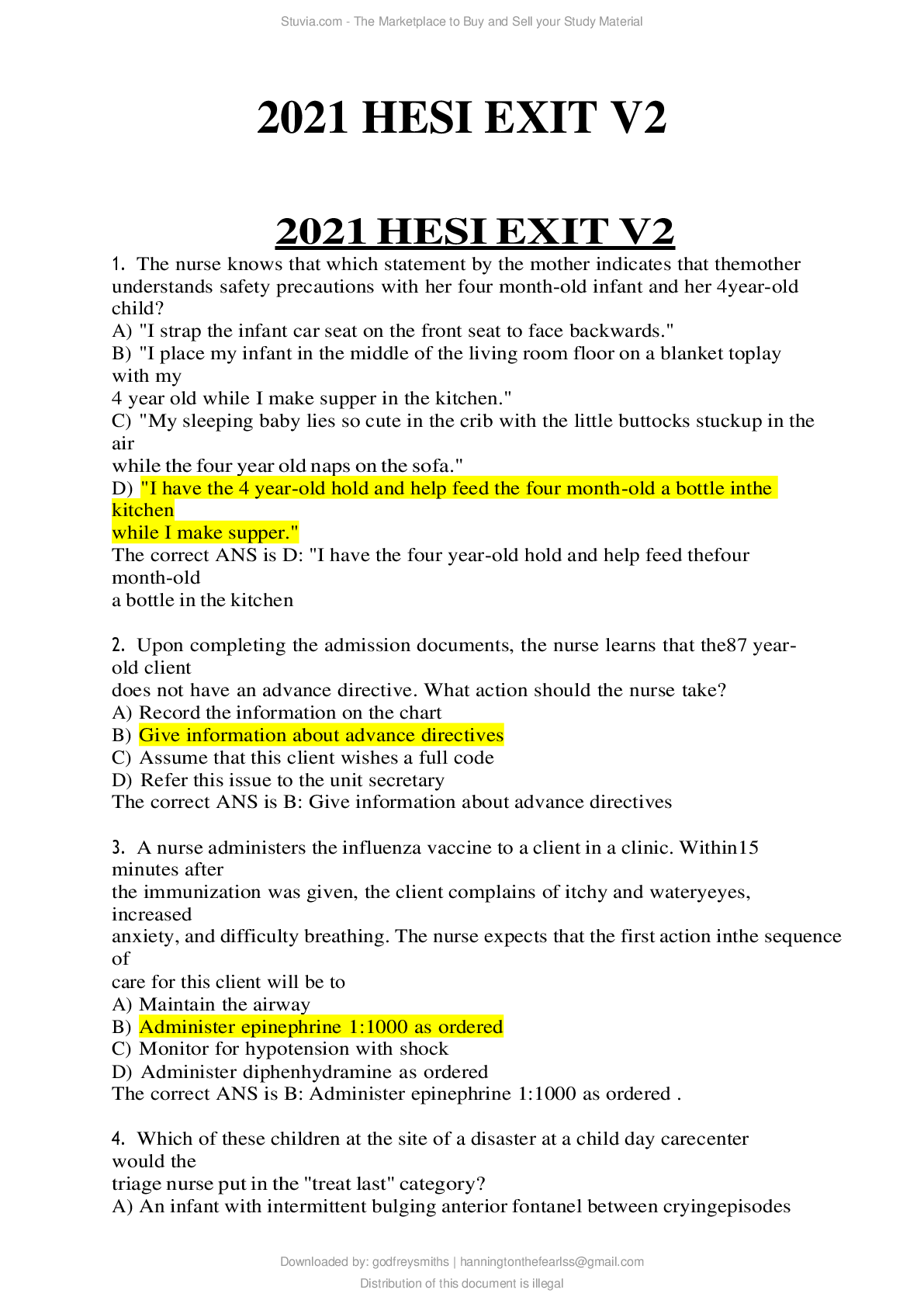


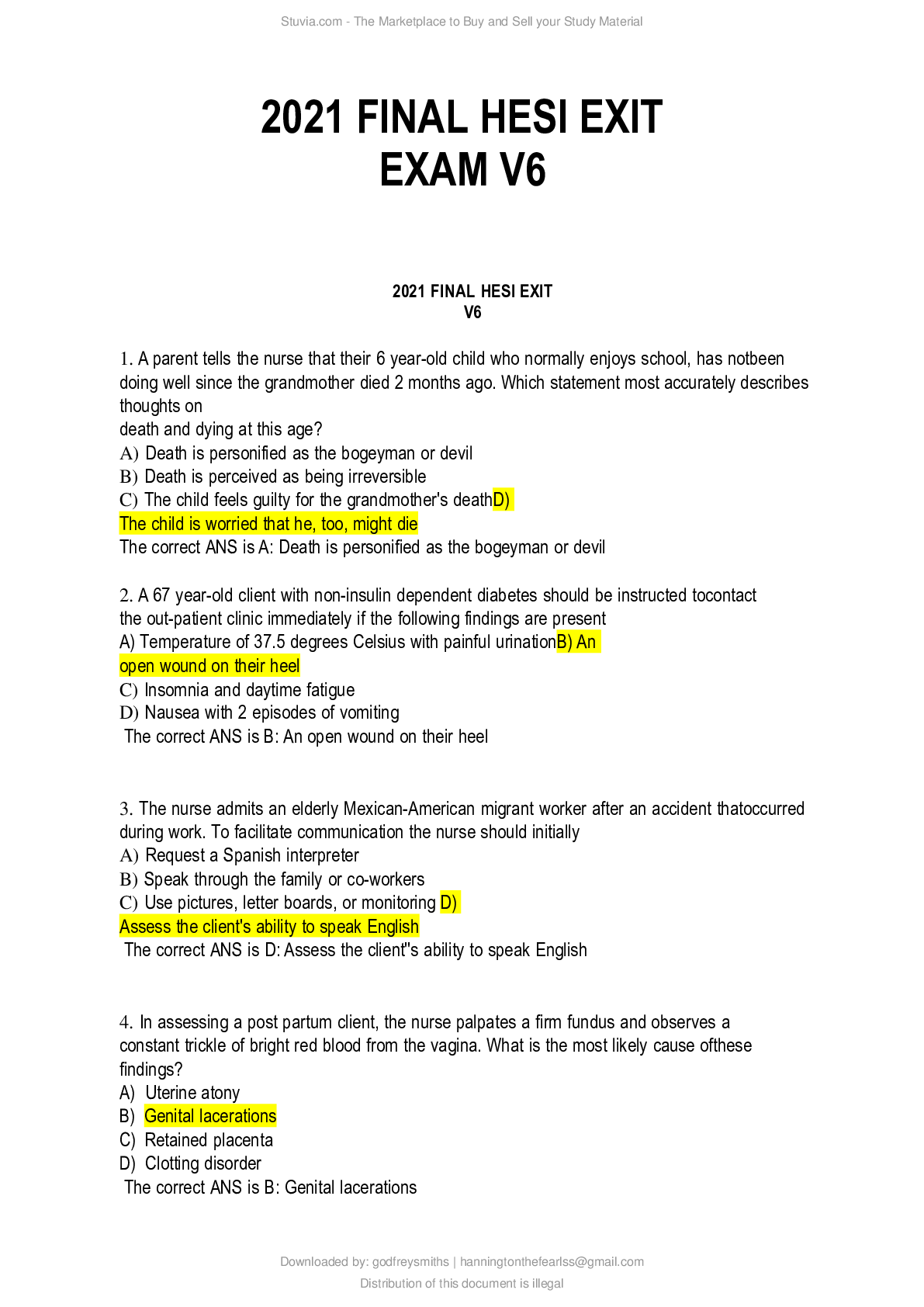
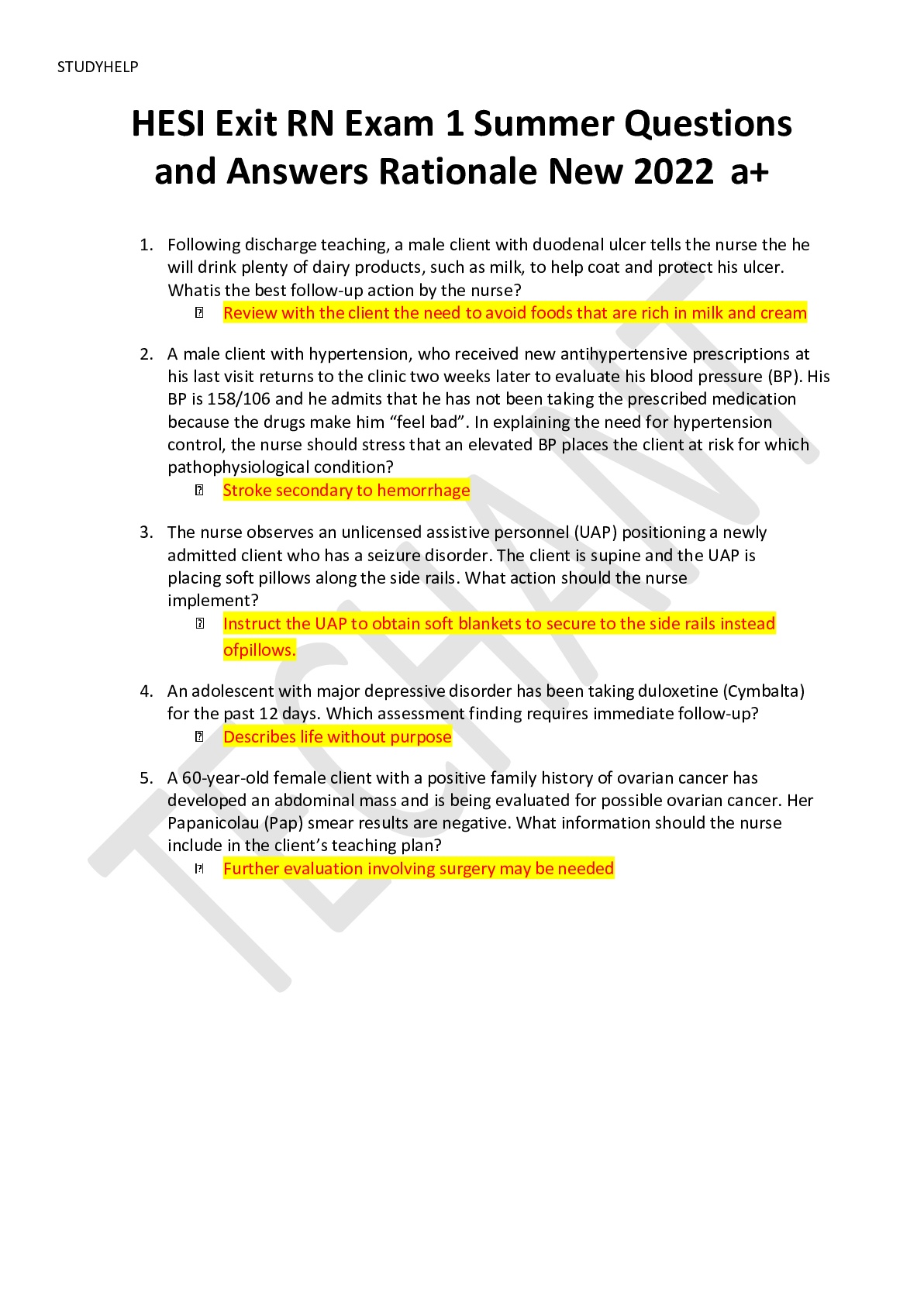

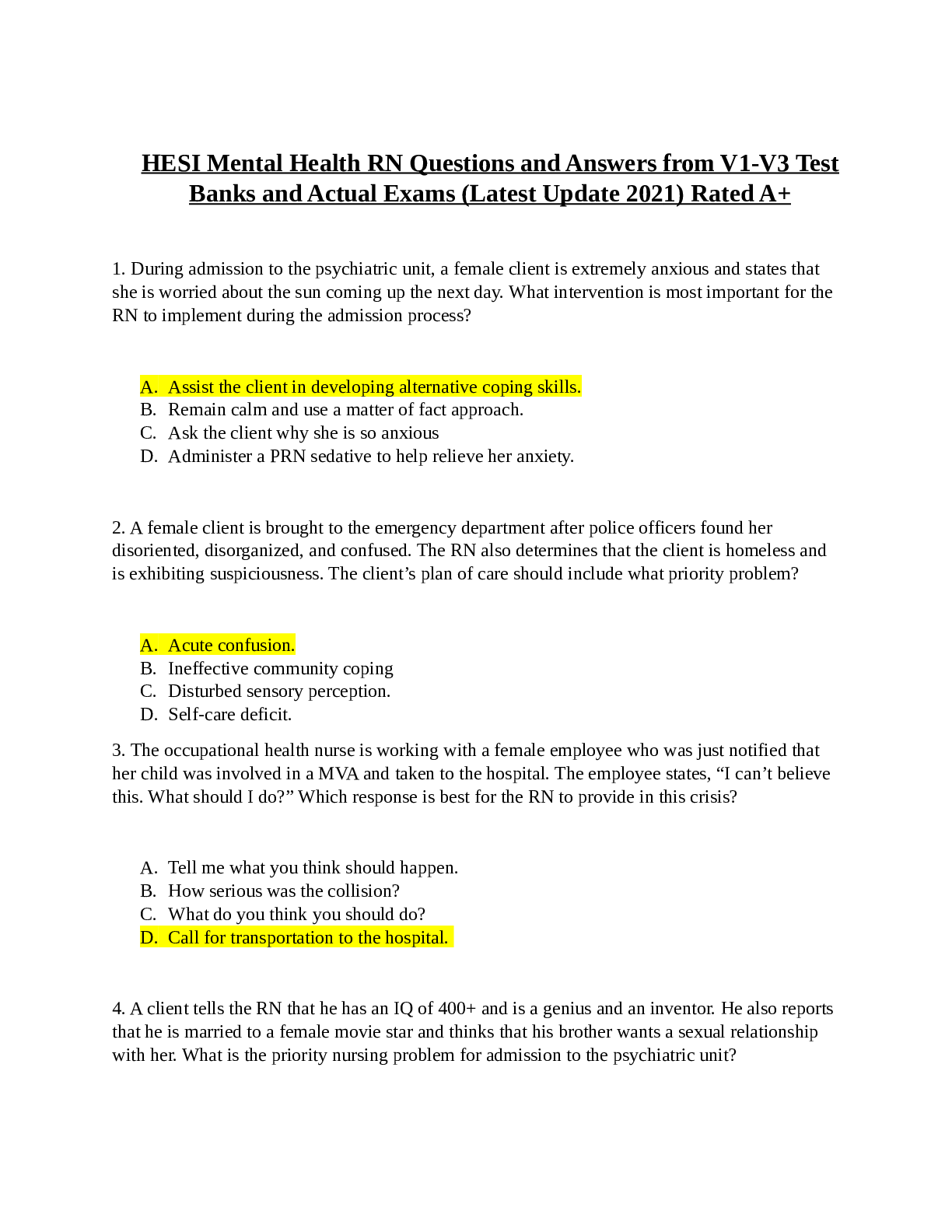
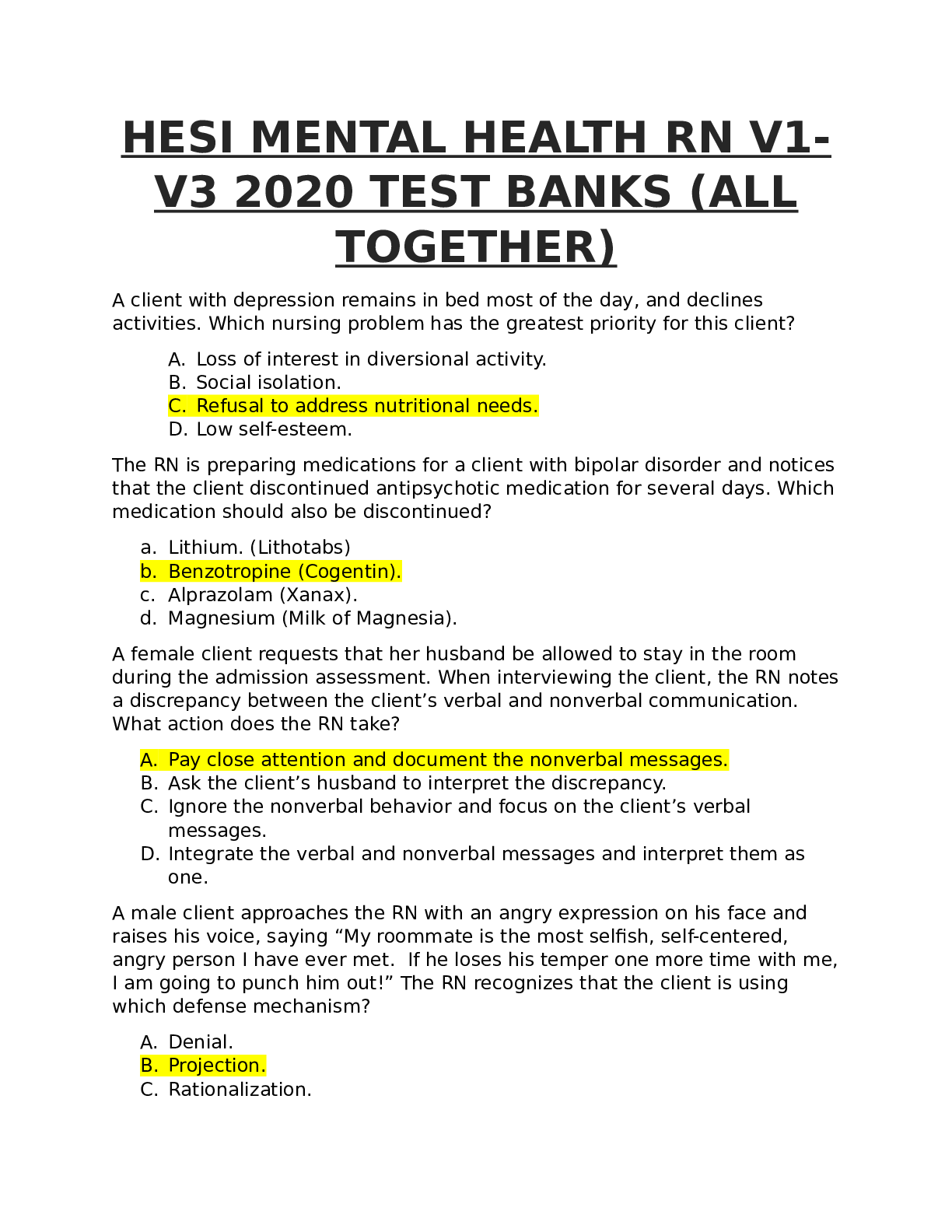
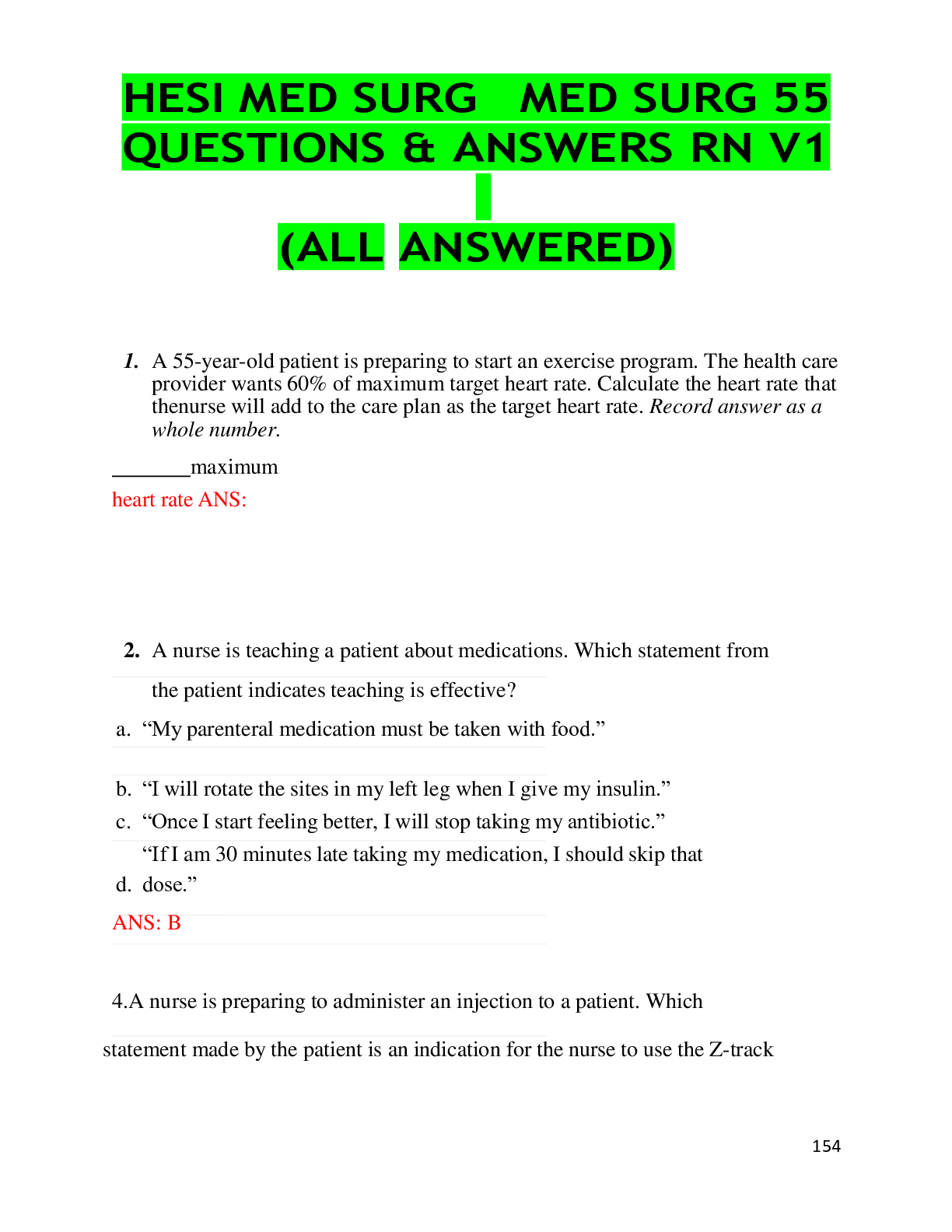
 LATEST QUESTIONS AND COMPLETE SOLUTIONS.png)


